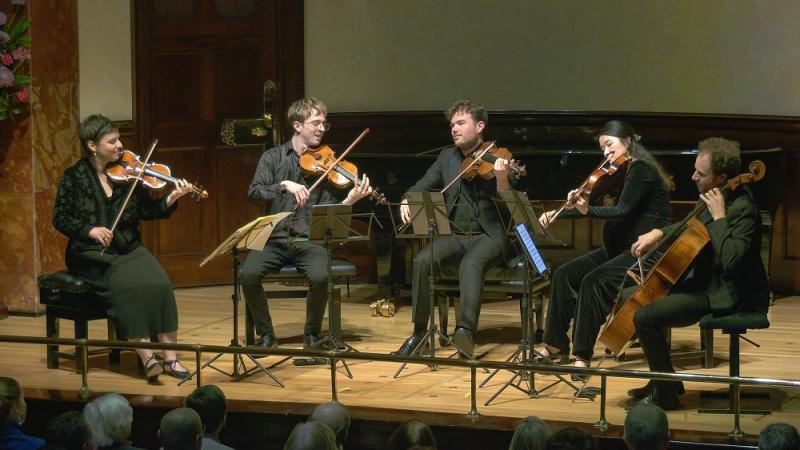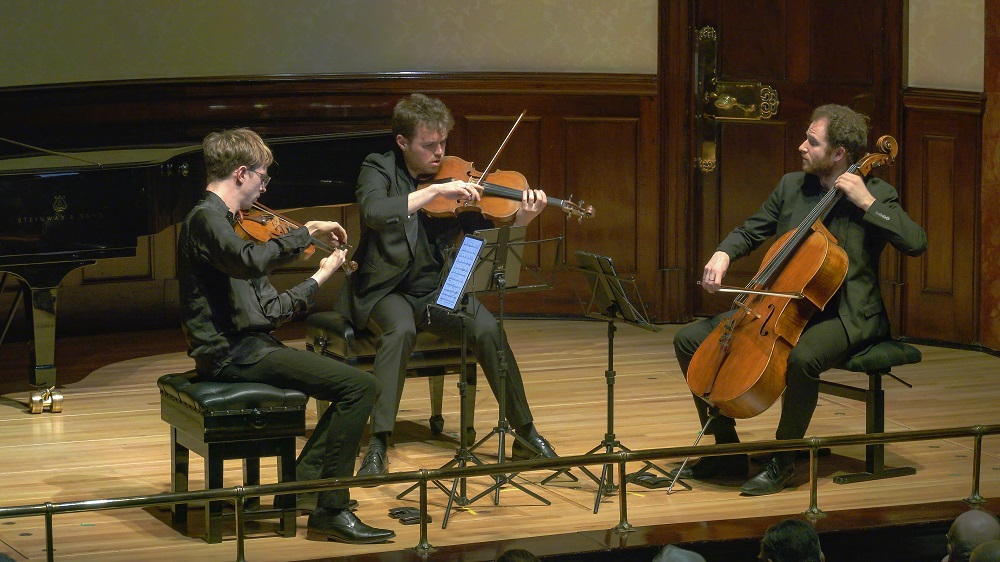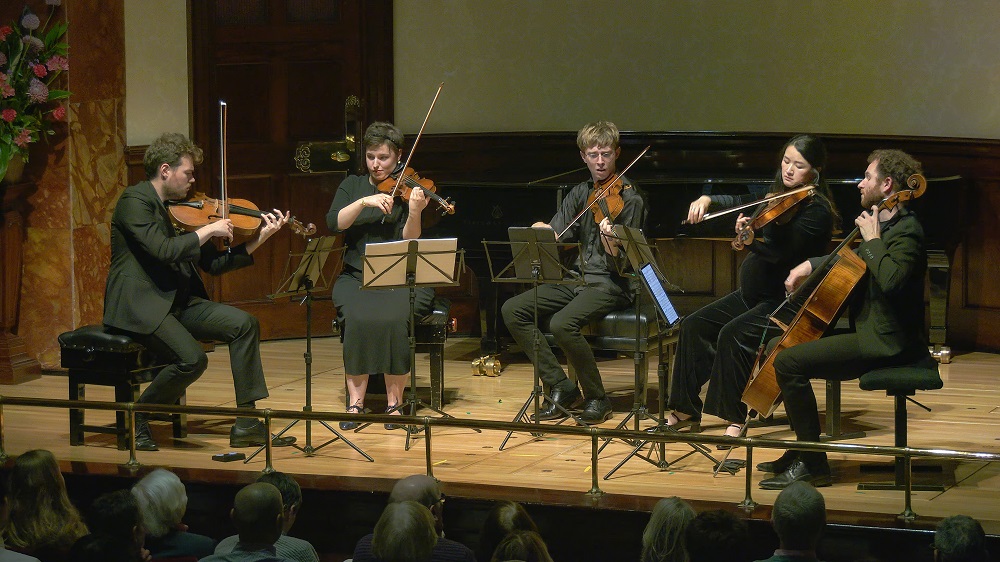Ridout, Włoszczowska, Crawford, Lai, Posner, Wigmore Hall review - electrifying teamwork | reviews, news & interviews
Ridout, Włoszczowska, Crawford, Lai, Posner, Wigmore Hall review - electrifying teamwork
Ridout, Włoszczowska, Crawford, Lai, Posner, Wigmore Hall review - electrifying teamwork
High-voltage Mozart and Schoenberg, blended Brahms, in a fascinating programme

Advice to young musicians, as given at several “how to market your career” seminars: don’t begin a biography with “one of the finest xxxs of his/her/their generation”. From my side, I’m allowed to use it occasionally: surely Timothy Ridout is the finest viola-player of his generation, and last night he struck sparks off four other artists at the top of their game: violinists Maria Włoszczowska and Tim Crawford, fellow viola-player Ting-Ru Lai and cellist Tim Posner
With any other musicians, I might have regretted not checking the programme carefully before I went: the Mozart string quintet wasn’t one of those late masterpieces which the octogenarian Richard Strauss studied, along with the complete works of Goethe, to affirm the Austro-German culture which the Nazi “barbarians” (his term) had nearly destroyed. And the Brahms string quintet in question turned out not to be the bracing Op. 111 but the far more often heard Clarinet Quintet with viola substituting for the wind instrument in Brahms’s own arrangement.
The Mozart was a revelation – in this performance, K174, engaging two violas, came across as another early work which gives the lie to the general notion that Mozart was accomplished in his youth, but that genius came later: there's an ambition here not far off the achievement of another 17-year-old, Mendelssohn, whose Octet dazzled those of us at the Academy of St Martin in the Field's second Marrnier centenary concert last week. This quintet's presentation was part of the magic: bold, free playing rather than galant prettiness, a rustic-sounding Minuet, speedy virtuosity in the finale. But the Haydnesque jokes are surely there already in Mozart's wanting to show how far he can go, and the shadowy unisons suggest a darkness beneath the surface, relating nicely to similar effects in Brahms's finale.  Ridout's ability to change a colour within a phrase and send even the commonplaces of the rococo era soaring gave another kick to this effervescent starter. Also extraordinary is the fact that the team seem to look more often at each other than at the music, suggesting that they know it by heart. Something of a miracle, this, in the Schoenberg Trio featuring "the three Tims" (pictured above) who've played together since their youth.
Ridout's ability to change a colour within a phrase and send even the commonplaces of the rococo era soaring gave another kick to this effervescent starter. Also extraordinary is the fact that the team seem to look more often at each other than at the music, suggesting that they know it by heart. Something of a miracle, this, in the Schoenberg Trio featuring "the three Tims" (pictured above) who've played together since their youth.
Although Schoenberg's serialism seems less rigorous in this late (1946) labyrinth - there are even triads in moments of relative relaxation, and a serene conclusion - the real difficulty, quite apart from the enormous technical demands, is the stop-start nature of the argument, supposedly reflecting the experiences of a near fatal heart attack and its aftermath three weeks before he composed the Trio. So well did these marvellous artists seem to have probed each idea, from the frenzied to the calm, that we went wth them, totally in the moment. Surely a landmark performance.  Viola for clarinet gives us a completely different experience in Brahms's Op.115: while several clarinettists in recent performances have taken the Quintet out of the "autumnal" category, the beautifully blended sound of five strings dialoguing intimately with each other restored that (both approaches are valid). Ridout took up what would normally be the first violin's place (pictured above), frequently soaring above Włoszczowska; their teamwork was magical throughout. The one place where the originally intended instrument might be missed is at the heart of the slow movement, where the agitated flurries still work better, I think, on clarinet. But this flowing third movement was peerless, and the dark colours of the finale once again benefitted from such intensive working-together. No wonder so many younger-generation musicians were in the audience, giving it a different atmosphere from the Wigmore usual.
Viola for clarinet gives us a completely different experience in Brahms's Op.115: while several clarinettists in recent performances have taken the Quintet out of the "autumnal" category, the beautifully blended sound of five strings dialoguing intimately with each other restored that (both approaches are valid). Ridout took up what would normally be the first violin's place (pictured above), frequently soaring above Włoszczowska; their teamwork was magical throughout. The one place where the originally intended instrument might be missed is at the heart of the slow movement, where the agitated flurries still work better, I think, on clarinet. But this flowing third movement was peerless, and the dark colours of the finale once again benefitted from such intensive working-together. No wonder so many younger-generation musicians were in the audience, giving it a different atmosphere from the Wigmore usual.
rating
Explore topics
Share this article
The future of Arts Journalism
You can stop theartsdesk.com closing!
We urgently need financing to survive. Our fundraising drive has thus far raised £49,000 but we need to reach £100,000 or we will be forced to close. Please contribute here: https://gofund.me/c3f6033d
And if you can forward this information to anyone who might assist, we’d be grateful.

Subscribe to theartsdesk.com
Thank you for continuing to read our work on theartsdesk.com. For unlimited access to every article in its entirety, including our archive of more than 15,000 pieces, we're asking for £5 per month or £40 per year. We feel it's a very good deal, and hope you do too.
To take a subscription now simply click here.
And if you're looking for that extra gift for a friend or family member, why not treat them to a theartsdesk.com gift subscription?
more Classical music
 BBC Proms: Barruk, Norwegian Chamber Orchestra, Kuusisto review - vague incantations, precise laments
First-half mix of Sámi songs and string things falters, but Shostakovich scours the soul
BBC Proms: Barruk, Norwegian Chamber Orchestra, Kuusisto review - vague incantations, precise laments
First-half mix of Sámi songs and string things falters, but Shostakovich scours the soul
 BBC Proms: Alexander’s Feast, Irish Baroque Orchestra, Whelan review - rapturous Handel fills the space
Pure joy, with a touch of introspection, from a great ensemble and three superb soloists
BBC Proms: Alexander’s Feast, Irish Baroque Orchestra, Whelan review - rapturous Handel fills the space
Pure joy, with a touch of introspection, from a great ensemble and three superb soloists
 BBC Proms: Moore, LSO, Bancroft review - the freshness of morning wind and brass
English concert band music...and an outlier
BBC Proms: Moore, LSO, Bancroft review - the freshness of morning wind and brass
English concert band music...and an outlier
 Willis-Sørensen, Ukrainian Freedom Orchestra, Wilson, Cadogan Hall review - romantic resilience
Passion, and polish, from Kyiv's musical warriors
Willis-Sørensen, Ukrainian Freedom Orchestra, Wilson, Cadogan Hall review - romantic resilience
Passion, and polish, from Kyiv's musical warriors
 BBC Proms: Faust, Gewandhausorchester Leipzig, Nelsons review - grace, then grandeur
A great fiddler lightens a dense orchestral palette
BBC Proms: Faust, Gewandhausorchester Leipzig, Nelsons review - grace, then grandeur
A great fiddler lightens a dense orchestral palette
 BBC Proms: Jansen, Royal Concertgebouw Orchestra, Mäkelä review - confirming a phenomenon
Second Prom of a great orchestra and chief conductor in waiting never puts a foot wrong
BBC Proms: Jansen, Royal Concertgebouw Orchestra, Mäkelä review - confirming a phenomenon
Second Prom of a great orchestra and chief conductor in waiting never puts a foot wrong
 BBC Proms: Royal Concertgebouw Orchestra, Mäkelä review - defiantly introverted Mahler 5 gives food for thought
Chief Conductor in Waiting has supple, nuanced chemistry with a great orchestra
BBC Proms: Royal Concertgebouw Orchestra, Mäkelä review - defiantly introverted Mahler 5 gives food for thought
Chief Conductor in Waiting has supple, nuanced chemistry with a great orchestra
 Dunedin Consort, Butt / D’Angelo, Muñoz, Edinburgh International Festival 2025 review - tedious Handel, directionless song recital
Ho-hum 'comic' cantata, and a song recital needing more than a beautiful voice
Dunedin Consort, Butt / D’Angelo, Muñoz, Edinburgh International Festival 2025 review - tedious Handel, directionless song recital
Ho-hum 'comic' cantata, and a song recital needing more than a beautiful voice
 Classical CDs: Dungeons, microtones and psychic distress
This year's big anniversary celebrated with a pair of boxes, plus clarinets, pianos and sacred music
Classical CDs: Dungeons, microtones and psychic distress
This year's big anniversary celebrated with a pair of boxes, plus clarinets, pianos and sacred music
 BBC Proms: Liu, Philharmonia, Rouvali review - fine-tuned Tchaikovsky epic
Sounds perfectly finessed in a colourful cornucopia
BBC Proms: Liu, Philharmonia, Rouvali review - fine-tuned Tchaikovsky epic
Sounds perfectly finessed in a colourful cornucopia
 BBC Proms: Suor Angelica, LSO, Pappano review - earthly passion, heavenly grief
A Sister to remember blesses Puccini's convent tragedy
BBC Proms: Suor Angelica, LSO, Pappano review - earthly passion, heavenly grief
A Sister to remember blesses Puccini's convent tragedy
 BBC Proms: A Mass of Life, BBCSO, Elder review - a subtle guide to Delius's Nietzschean masterpiece
Mark Elder held back from blasting the audience with a wall of sound
BBC Proms: A Mass of Life, BBCSO, Elder review - a subtle guide to Delius's Nietzschean masterpiece
Mark Elder held back from blasting the audience with a wall of sound

Add comment